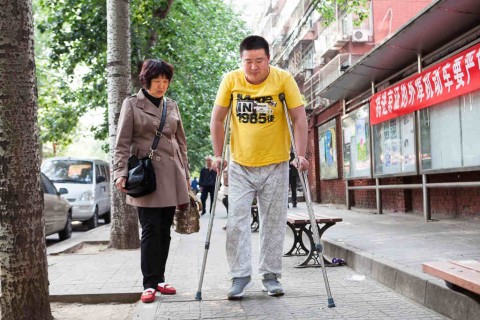مشاكل الحركة والتنسيق
يمكن أن يسبب التصلّب العصبي المُتعدِّد مشاكل في الحركة والتوازن والتنسيق
Last updated: 14th March 2025
ماذا يوجد في هذه الصفحة؟

After years in a wheelchair Little Gao is able to walk a few steps with crutches. It is good for him to flex the muscles in his legs and aids his physical recovery. Reproduced with the kind permission of Li YouHao,© 2014 Li
يمكن أن يسبب التصلّب العصبي المُتعدِّد مشاكل في الحركة والتوازن والتنسيق، بما في ذلك:
- فقدان التوازن
- الارتعاش
- المشي غير المستقر (الترنّح)
- الدوار (الدوخة)
- انعدام رشاقة أحد الأطراف
- غياب التنسيق
- ضعف العضلات
- شد أو تصلب أو “سحب” العضلات (التشنجات)
- تشنجات عضلية لا إرادية
غالبًا ما تكون هذه المشاكل مسؤولة عن العجز البدني الذي يمكن أن يتزايد في حالة التصلّب العصبي المُتعدّد بمرور الوقت.
يُعتقد أن مشاكل الحركة ناتجة عن تلف الميالين في المُخيخ ووصلاته، مما يضعف عمل الشبكة، ويتسبب في حركات غير منسّقة. وقد تم تشخيص فقدان التوازن والدوار بسبب الآفات في المسارات المعقدة التي تنسق المدخلات البصرية والمكانية وغيرها من المدخلات للدماغ اللازمة لضمان توازن الجسم والحفاظ عليه.
هل يمكن معالجة هذه الأعراض أو مداواتها؟
غالبًا ما يمكن التخفيف من هذه الأعراض من خلال العلاج الطبيعي، وفي كثير من الحالات، تكون التدخلات الأولية مثل حركات الإطالة والتمدد وممارسة التمارين وإعادة التأهيل مفيدة في هذا الصدد.
يُستخدم عدد من الأدوية لعلاج التشنجات، بما في ذلك باكلوفين وتيزانيدين وديازيبام ودانترولين، على الرغم من أن لها آثارًا جانبية قد تمنع بعض الأشخاص من تحملها.
ولا يوجد سوى عدد قليل من العلاجات الدوائية التي ثبت أنها تساعد في علاج الترنّح أو الارتعاش، وهناك بعض الخيارات الجراحية لهذه الأعراض المحددة.
عادة ما يتم علاج ضعف التوازن والدوار بأدوية دوار الحركة.
Madrid, Spain, 10/2011. Heads turn at the zoo’s amphitheatre as David carries his wife, Almudena, up to her seat. On the platform below, her wheelchair is equally eye-catching among a small horde of baby strollers. Making sure their son has an active life is more important than giving any serious consideration to how strangers react to the ways they cope with living with MS. Credit: Lurdes R. Basolí. Published with kind permission of the European Multiple Sclerosis Platform.
San Quirico D'Orcia, Italy, 02/2012. Martina Vagini has balance problems; in addition to using canes, she takes the trouble to go to the side of a wide staircase to be close to the railing. In a country like Italy, disability and history create a difficult barrier: laws that encourage (or even mandate) public buildings to improve accessibility often collide with laws that protect artistic heritage. Italy ranks fifth in the world as a tourist destination: in difficult economic times, beauty for the visitor often trumps access for the locals. Credit: Carlos Spottorno. Published on this website by kind permission of the European Multiple Sclerosis Platform.